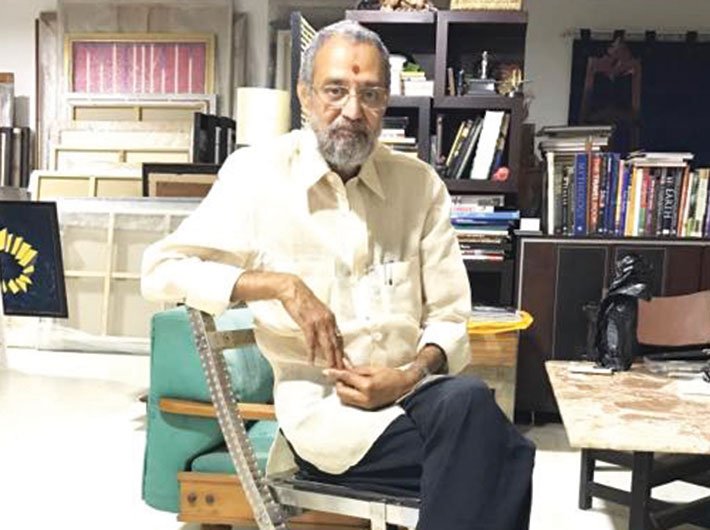He accompanied his father to film studios in Chennai and helped him in designing sets, but Thota Tharrani wanted to be an artist. So he studied mural painting and print-making, but as luck would have it, he finally returned to tinsel town. And the world soon took note. In Mani Ratnam’s path-breaking Nayagan (1987), viewers had no clue which scenes were shot in Mumbai’s Dharavi and which in Chennai’s Venus Studio. Over the decades, he worked in a slew of big-budget movies in Tamil, Telugu, Malayalam and Hindi, winning two National Film Awards.
What is an artist’s role in society?
There are many ways in which an artist can play a role in society: contributing to charitable trusts, designing for festivals, and media. For example, I designed for the South Zone Cultural Centre, as an art director and designer, for five consecutive years. I painted the national flag for Bharath Bala and AR Rahman’s album Vande Mataram. I have donated many of my works to charitable associations, especially kidney foundations. I did all this when I was hard up myself. But I am happy.
What problems did you initially face in the industry?
Even today we face problems. It’s very rare to get the right budget to do what producers want. At the same time we have to give them the effect of my drawing, with the guidance of the story and from the director, and give provision for the director of photography to work, and then satisfy the budget of the producer. Ultimately we withhold tension and burden throughout the film set in order to get the finished product. I am yet to know whether the producers understand the tensions we go through all the time. Sometimes (almost always) most of them come up with work with a limited period of time.
How has been your association with art and cinema?
I have been in the field of art and cinema for 52 years. Painting is more personal to me and working on a set is more of an ensemble. But, the influence can never be distinguished (figured out) between art to cinema or cinema to art. Since I still work out on pencil sketches and drawings (for film sets as well), I treat the film frame as a canvas.
What brought you closer to art?
My father encouraged me towards art when I was three-and-a-half- or four-year-old, when he noticed me drawing a Buddha with a chalk piece on the floor. He then brought me drawing books for freehand drawing. I later joined the college of arts and completed my diploma. My father who was a very famous theatre person and he played many female roles in Machilipatnam. He also studied arts in college and drew paintings. Later he came to Chennai to become an actor but failed, and eventually became an assistant art director in AK Sekhar and Uday Shankar’s films. I accompanied him. I slowly branched into becoming an assistant art director and then an art director. In congruence with this, I worked as an assistant visualiser at Sistas Advertising in Bombay (1970-71) and won three Communications Arts Guild (CAG) awards. But through all this, I never gave up painting.
Have you ever thought of acting in cinema?
I never wanted to. But I have made cameo appearances for Kamal Haasan and Kasinadhuni Viswanath’s movies. I have also acted as Swami Chinmayananda. But I prefer to stay behind the camera. Once you appear as an actor on screen, you can’t walk as quietly as you usually would in public.
An anecdote you’d like to share related to your work.
I would like to share the one which moved me. I used to travel to Kolkata where I had a friend, Mr Tavday, who did a couple of my shows. For the shows, I drew on cardboards or any material I could find. I had given those works to the people who were helping me during the show. One of them was Ahmed. One day, after 20 years, I walked into Chemould Art Gallery. By that time, Mr Tavday had passed away. I had asked for Ahmed and the lady at the entry told me he was out. I later met him outside the gallery, where he told me that he had a painting of mine which he had sold in order to get his daughter married. He kept apologising since it was a gift. But this moved me a lot.
What are you currently working on?
I am currently working on my paintings and experimenting on my artwork since I’ve no film projects at hand.
Where do you see India 10 years from now?
I already feel we are at par with international standards. India is being recognised worldwide and it’s excelling in many fields. We’ll also have to make it stand and be proud of our country. I do feel in 10 years we’ll be at the top.
What is your advice to the young generation?
We never had facilities like the generation today has. I still try to use today’s materials in my work and experiment with it. It’s tough to stand in today’s world. It is in no way simple in just acquiring and keeping up to your name. So, I’d like to say, work hard. Work with sincerity and dedication. You can never get your lost time.
(The interview appears in the April 16-30, 2017 issue of Governance Now)

